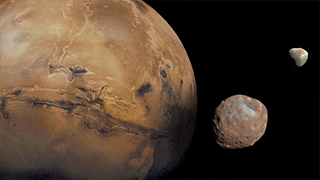- One of five planets known to ancients; Mars was Roman god of war, agriculture and the state
- Yellowish brown to reddish color; occasionally the third brightest object in the night sky after the Moon and Venus
- Average diameter 4,212 miles (6,780 kilometers); about half the size of Earth, but twice the size of Earth's Moon
- Same land area as Earth, reminiscent of a cold, rocky desert
- Mass 1/10th of Earth's; gravity only 38 percent as strong as Earth's
- Density 3.9 times greater than water (compared to Earth's 5.5 times greater than water)
- No planet-wide magnetic field detected; only localized ancient remnant fields in various regions
- Fourth planet from the Sun, the next beyond Earth
- About 1.5 times farther from the Sun than Earth is
- Orbit elliptical; distance from Sun varies from a minimum of 128.4 million miles (206.7 million kilometers) to a maximum of 154.8 million miles (249.2 million kilometers); average is 141.5 million miles (227.7 million kilometers)
- Revolves around the Sun once every 687 Earth days
- Rotation period (length of day) is 24 hours, 39 minutes, 35 seconds (1.027 Earth days)
- Pole is tilted 25 degrees, creating seasons similar to those on Earth
- Atmosphere composed chiefly of carbon dioxide (95.3%), nitrogen (2.7%) and argon (1.6%)
- Surface atmospheric pressure less than 1/100th that of Earth's average
- Surface winds of 0 to about 20 mph (0 to about 10 meters per second), with gusts to about 90 mph (more than 100 kilometers per hour)
- Local, regional and global dust storms; also whirlwinds called dust devils
- Surface temperature averages minus 64 Fahrenheit (minus 53 Celsius); varies from minus 199 Fahrenheit (minus 128 Celsius) during polar night to 80 Fahrenheit (27 Celsius) at equator during midday at closest point in orbit to Sun
- Highest point is Olympus Mons, a huge shield volcano about 16 miles (26 kilometers) high and 370 miles (600 kilometers) across; has about the same area as Arizona
- Canyon system of Valles Marineris is largest and deepest known in solar system; extends more than 2,500 miles (4,000 kilometers) and has 3 to 6 miles (5 to 10 kilometers) of relief from floors to tops of surrounding plateaus
- Two irregularly shaped moons, each only a few miles (kilometers) wide
- Larger moon named Phobos ("fear"); smaller is Deimos ("terror"), named for attributes personified in Greek mythology as sons of the god of war






